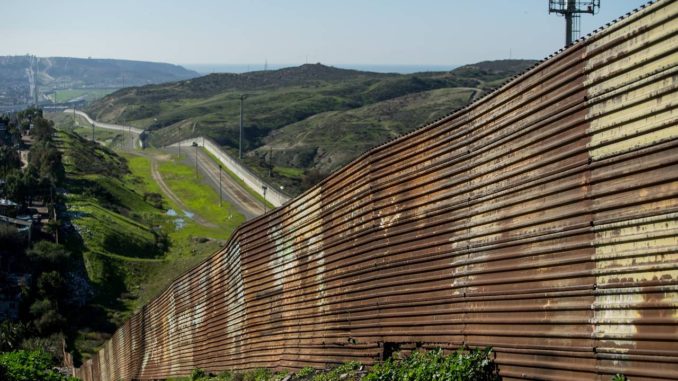
Donald Trump has promised to build an “impenetrable, physical, tall, powerful, beautiful” wall along the southwest border of the U.S. to keep out illegal immigrants and criminals. This week, before the first brick has been laid, his administration claimed that the mere threat of such a crackdown was already bearing results. In February, the first full month of Mr. Trump’s presidency, the U.S. Border Patrol said that it had intercepted 18,762 illegal migrants at the southwest border, 41% fewer than in January and 28% fewer than in February 2016.
A single month’s figures should be treated with caution, but Mr. Trump may well have made the U.S. less attractive to Mexicans. After all, his early actions as president seem to have deterred other would-be visitors, with travel firms reporting a drop in searches for flights to the U.S. since his inauguration.
The question is whether the wall itself, and the other pricey physical defenses that Mr. Trump has promised, would keep out even more migrants. The likely answer is no, and such measures might have some unhappy unintended consequences.
We have a good idea of what happens when security at the border is tightened because over the past few decades, the U.S. has been making things much stricter. Looking north toward California from the hilly suburbs of Tijuana, Mexico, one sees an imposing modern barrier, topped with razor wire and monitored by night-vision cameras. Drones patrol the skies, and radar scans below ground for illicit tunnels. Between 1992 and 2008, the U.S. Border Patrol quadrupled the number of hours that its agents spend guarding the 2,000-mile frontier, according to the Department of Homeland Security.
By one measure, this crackdown has worked. Undocumented migrants have found it much harder to get across unaided, so more of them have sought professional help. In the 1970s, less than half of illegal migrants into the U.S. hired the services of a “coyote,” as people-smugglers are often known. By 1999, nine out of 10 did, according to research cited by DHS.
As crossing the border became more complicated, the coyotes raised their prices. Between 1993 and 2007, the average fee for an illegal passage roughly doubled in real terms. Research by DHS shows a neat link between the number of line-watch hours put in by the Border Patrol and the average fee paid to coyotes, whose tool kits now include GPS trackers and high-powered electric fence-cutters.
The going rate for a basic crossing now starts at around $3,000, according to the Mexican Migration Project at Princeton and Guadalajara universities. A business-class service, providing fake documentation to avoid a dangerous slog across the desert, can run to five figures.
Crossing the border used to be a relatively easy business that people often did on their own. Today, few migrants attempt it without increasingly expensive help from an ever more professional class of criminal, and the number of migrants has indeed dropped dramatically.
But correlations can be deceiving. What has actually produced this decline? Looking back over the past several decades, it is hard to see that the level of border security has made much of an impact. In fact, the main driver of fluctuations in the number of illegal immigrants has been the ups and downs of the U.S. economy.
The Pew Research Center points to the rapid economic growth of the late 1990s to explain the great uptick in immigration through 2000. Indeed, migration fell again after the recession of the early 2000s, rose a bit as the U.S. economy rebounded, then plunged as the housing market (and construction jobs) collapsed in the wake of the financial crisis.
Between 1991 and 2000, Border Patrol enforcement hours increased by some 150%—but there was no fall in illegal migration, according to Pew’s estimates. In fact, the number of people being apprehended at the border each year rose by half, and the total number of Mexican migrants living in the U.S. (most of them illegally) doubled. Making the border tougher did raise the price that undocumented migrants had to pay to cross it—but most of them simply chose to absorb the extra cost.
That Mexican migrants are largely insensitive to these price changes isn’t surprising. Mexico’s minimum wage is around $4 a day. In the U.S., a worker can make that much in a half-hour, even working illegally. The economic incentive to migrate northward is strong enough to withstand having to pay even several thousand dollars more for entry.
Nor is raising this sort of money upfront as hard as one might think. Would-be migrants may be poor, but they can often draw on funds from relatives who have already made the crossing.
Ironically, much as migrant workers from Mexico and beyond may be put off by Mr. Trump, his broader economic plan may draw more of them to the U.S. He has promised a federal splurge on construction, something in which undocumented migrants have long specialized. Big infrastructure projects would create more demand for labor in these industries, and higher wages would exert a strong pull.
Workers would have even more reason to move north if Mr. Trump rips up the North American Free Trade Agreement, which has helped to make Mexico one of Latin America’s richer countries. A trade war with Mexico would send more of its citizens out of the country in search of work.
So what would be the likely effect of Mr. Trump’s wall and the extra 5,000 Border Patrol agents that he has requested? Most of the accessible parts of the border are already well fenced and guarded. The thousand-plus miles of frontier that lack fencing mostly run through natural barriers, such as deserts or rivers, making such stretches hard to cross (and expensive to build on). As for drugs and other contraband, most of it is smuggled through by car or truck, not lugged across the desert.
Tighter security would probably make the border somewhat harder to cross, which would have several consequences—though perhaps not the ones meant by Mr. Trump. Even more illegal migrants would turn to professional criminals for help, and the fees charged by those people-smugglers would rise. The expertise required to get a person over today’s border already means that drug cartels are getting into what was previously an amateur business, sometimes loaning out their tunnels for people-smuggling. Even so, because illegal migrants are largely insensitive to changes in price for these services, their number is unlikely to diminish much.
The construction of a “tall, powerful, beautiful” wall in the wilderness would serve mainly to inflate the profit margins of the people-smuggling industry—enriching the very “bad hombres” whom Mr. Trump says he wants to keep at bay. That isn’t a smart use of money, whoever ends up paying for it.
Wainwright is Britain editor of the Economist and the author of “Narconomics: How to Run a Drug Cartel” (PublicAffairs).



